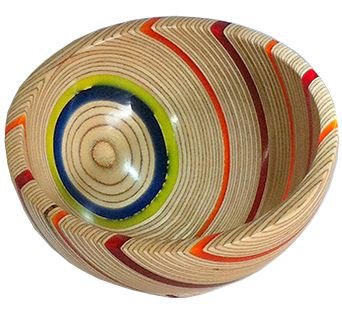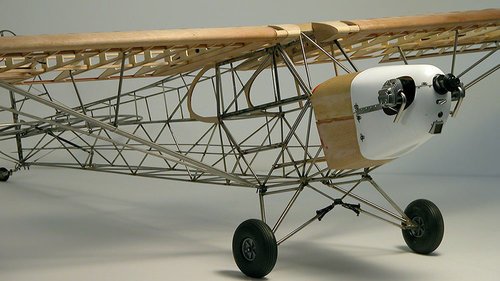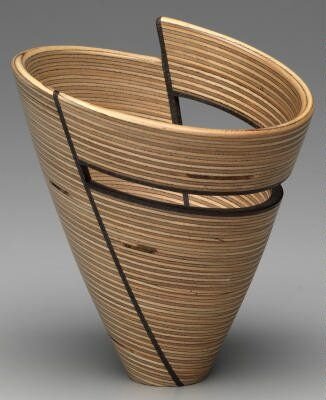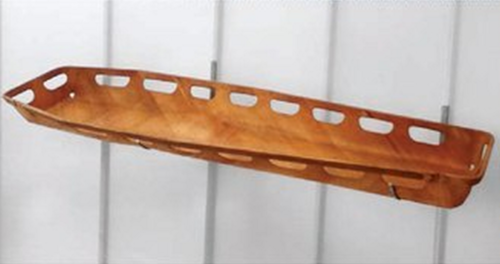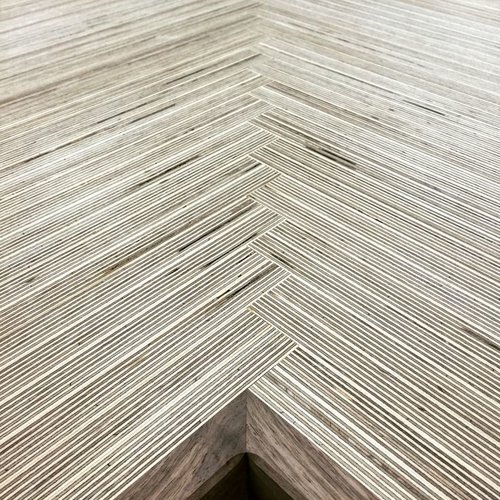Why plywood?
Plywood is a popular choice when it comes to home interiors and by now, most people will be familiar with its distinctive stripe pattern, wood surface and ability to bend into smooth curves, but what exactly is it and how is it made?
As the name suggests, plywood is a manufactured wood product. No matter the type of plywood it’s always made in the same way: by glueing and then pressing thin layers of wood (known as plies) together to form either flat solid sheets or curved shapes. Just like solid wood, the wood grain in ply and veneers run at a specific angle, making the ply bendable and pliable in one direction but not the other. Each ply is laid with its grains running at opposing angles, giving the contrasting stripe effect you see on the side of plywood boards and in most Lozi pieces.
This technique known as cross-graining stops plywood from splitting, warping, expanding, shrinking or bending, creating a very versatile product that is more durable, stronger and cheaper to manufacture than solid wood. Laying plies at lower angles to one another (at 45 degrees rather than 90 degrees for example) increases the strength of the final material, but also increases waste as the plies need to be cut at an angle. Most commercial plywood has each ply going at 90 degrees to the adjacent ones. The strength and properties of each type of plywood depend also on the number of plies (always an uneven number) type of wood and glue used as well as any finishings applied.
Grain directions via Plywood Inspection
Grain directions via Wood Technology
Sheets of ply and veneers are created on a rotary lathe, a large industrial rotating saw that shaves an entire tree trunk into one long continuous sheet of wood veneer. These sheets are then cut to size, patched if needed, layered with their grains at opposing angles, glued, pressed and shipped. The V&A has released this fascinating video following the manufacturing of plywood in 1954 and 2016. The manufacturing process has changed little in the last 60 years, apart from inevitable digitisation.
Plywood is one of the most versatile materials out there, used in many different industries, from furniture to construction, flooring, aircraft and marine development. There are many different types of plywood; depending on the manufacturing process it can be used indoors and out, for mass production or delicate artistry, as a hidden away supporting material or as a decorative feature.
You will notice that Lozi uses a wide range of plywood - look at the first pictures in this post to see some of the differences in colour and thickness of each ply. The makers at Lozi carefully assemble their own plywood to give each piece the desired look and properties (weight baring, easily shaped, simple assembly etc etc). Each Lozi piece is first digitally designed then plywood pieces are cut with a CNC router. Curved features are created by assembling a carefully selected series of plies, glueing them together then shaping them over jigs in a vacuum press. Once the glue has dried, the pieces are assembled, sanded, checked for imperfections and finished by hand. The perfect mix of digital manufacturing and traditional techniques.
Lozi's CNC Router, used to cut each piece of plywood to an exact digitally designed shape.
Jigs used to shape the plywood sheets into smooth curves after they have been cut.
Once to the curved pieces have dried they are inspected and assembled.
And finally each piece if sanded down, checked for imperfections and finished to the highest standards.
The first documented use of wood veneers can be traced back to ancient Egypt, approximately 1500 BC. The casket of King Tut-Ankh-Amon was decorated with thin pieces of dark ebony, though made of solid cedar wood. Used during ancient Greek and Roman times, this technique became known as veneering in the 16th century and forms the basis of modern plywood.
The first mention of materials resembling modern plywood dates back to 1797, when Sir Samuel Bentham applied for a series of patents for machines to create wood veneers. In these patent applications, he describes glueing or laminating several thin layers of wood together to create a thicker piece - this is considered the first known description of modern day plywood. 50 years later, Immanuel Nobel (Father of Alfred Nobel) realised that glueing several thinner layers of wood together at opposing angles resulted in a significantly stronger piece of wood and invented the rotary lathe in order to commercialise his discovery.
The next 50 years history of plywood is unclear, though the process is referenced in a french dictionary from 1870, in an entry entitled "Deroulage". Plywood became a more commonly used material in the US and UK during the second half the the 19th century but it wasn't until 1928 that production became standardised. Originally considered a cheap material, plywood was mainly hidden, disguised under beautiful veneers or upholstery, until the 1930's when designers like Alvar Aalto started to celebrate it and showcase it in all its industrial beauty. Unlike steel or aluminium, plywood could be manipulated and worked with in small scale workshops without the need for full industrial factories, allowing designers more freedom to experiment. See our review of the V&A's Plywood - Material of the Modern World exhibition for more information on the last 150 years history of plywood.
Plywood has historically been used in many unexpected products, from fighter jets in the 2nd world war to stretchers and flat pack housing. It is now even being used as a wood turning material, bringing the story full circle. A truly exceptional material, whose worldwide standardised production makes it extremely versatile, it is durable, easy to work with and looks beautiful once finished.
The first documented use of wood veneers can be traced back to ancient Egypt, approximately 1500 BC. The casket of King Tut-Ankh-Amon was decorated with thin pieces of dark ebony, though made of solid cedar wood. Used during ancient Greek and Roman times, this technique became known as veneering in the 16th century and forms the basis of modern plywood.
The first mention of materials resembling modern plywood dates back to 1797, when Sir Samuel Bentham applied for a series of patents for machines to create wood veneers. In these patent applications, he describes glueing or laminating several thin layers of wood together to create a thicker piece - this is considered the first known description of modern day plywood. 50 years later, Immanuel Nobel (Father of Alfred Nobel) realised that glueing several thinner layers of wood together at opposing angles resulted in a significantly stronger piece of wood and invented the rotary lathe in order to commercialise his discovery.
The next 50 years history of plywood is unclear, though the process is referenced in a french dictionary from 1870, in an entry entitled "Deroulage". Plywood became a more commonly used material in the US and UK during the second half the the 19th century but it wasn't until 1928 that production became standardised. Originally considered a cheap material, plywood was mainly hidden, disguised under beautiful veneers or upholstery, until the 1930's when designers like Alvar Aalto started to celebrate it and showcase it in all its industrial beauty. Unlike steel or aluminium, plywood could be manipulated and worked with in small scale workshops without the need for full industrial factories, allowing designers more freedom to experiment. See our review of the V&A's Plywood - Material of the Modern World exhibition for more information on the last 150 years history of plywood.
Plywood has historically been used in many unexpected products, from fighter jets in the 2nd world war to stretchers and flat pack housing. It is now even being used as a wood turning material, bringing the story full circle. A truly exceptional material, whose worldwide standardised production makes it extremely versatile, it is durable, easy to work with and looks beautiful once finished.









